We are the guardians of our client's well-being when they travel. But we also need to be the custodians of their personal information in the best ways available to us.
from HOTELMARKETING.COM https://ift.tt/2LPXZUi
Thursday, May 31, 2018
Travel industry must do more to protect client data
Sojern data shows latest travel trends
Sojern published its latest Global Travel Insights report, which offers a quarterly look at travel trends from around the world.
from HOTELMARKETING.COM https://ift.tt/2JagIba
A hotel or a destination?
The Royal Crescent Hotel & Spa already enjoyed a loyal guest following. However, they wanted to shift brand perception among customers; rather than visiting Bath, they wanted guests to feel like The Royal Crescent & Spa itself was the destination.
from HOTELMARKETING.COM https://ift.tt/2LPn4Pl
Why hotel brands should really be scared of Expedia
What is preventing OTAs from initiating their own hotel brands, just like the Marriotts and Hiltons of the world?
from HOTELMARKETING.COM https://ift.tt/2LP22QQ
The value of hotel-direct bookings is measured by more than numbers
In addition to the data science involved in revenue strategy, customer relationships matter a great deal to a hotel's success.
from HOTELMARKETING.COM https://ift.tt/2J8qoD8
Hotel rates and bookings continue growth throughout first half of 2018
According to new TravelClick data, North American hoteliers continue to experience significant growth in the second quarter of 2018 across all travel segments, up 2.7 percent in average daily rates and 1.4 percent in bookings.
from HOTELMARKETING.COM https://ift.tt/2LNETy7
Sabre plans to integrate NDC content in GDS
Sabre will take steps that will enable customers to shop and book New Distribution Capability (NDC) content alongside traditional content in the Sabre Red Workspace.
from HOTELMARKETING.COM https://ift.tt/2xwuxiV
Business travelers value hotel rewards over safety
A survey of 2,000 business travellers around the world by Carlson Wagonlit Travel shows Americans are the most happy to compromise safety for rewards, followed by Europeans and those from Asia Pacific.
from HOTELMARKETING.COM https://ift.tt/2LOQaOL
601 Beach Crescent in Vancouver
601 Beach Crescent by Pinnacle International is a new 52-storey highrise development located on the east side of the Granville Street Bridge, in Downtown Vancouver. The proposal calls for approximately 300 market homes within the tower, plus a large lot-spanning podium with 152 non-market housing units, with a total square footage of 126,710 square feet. The non-market housing unit mix is 13% studios, 50% one-bedroom, 20% two-bedroom and 16% three-bedroom.
The post 601 Beach Crescent in Vancouver appeared first on Vancouver New Condos.
from Buildings – Vancouver New Condos https://ift.tt/2svqPAv
Top Tips for Traveling Alone
Whether you love solo travel or just lack a dive buddy, no one likes the extra fees often facing travelers who claim a room for themselves. Termed a ‘single supplement,’ this additional fee tacks on anywhere from 10 to a whopping 100 percent of the standard room rate to your bill if you don’t meet the double-occupancy guidelines. Here are our eight top tips for traveling alone and avoiding the dreaded single supplement on your next dive trip.
Travel with a dive shop
Sign up for a group trip and avoid the ‘single’ part altogether. Dive shops often offer group trips to tropical locales like the Bahamas or even far-flung destinations like the Maldives. They’ll also pair you up with a good dive buddy. Though your local dive shop remains an easy first choice, you’re not limited to businesses in your area. Many dive shops also offer out-of-state divers a chance to join their trips.
Share a room
Land-based properties usually require a single supplement unless you’re in a shared room. Often designed for backpackers, these rooms generally house at least two travelers and sometimes many more. You’ll share bathroom facilities but enjoy access to a kitchen, which can also cut down on your meal costs. We adore the Agnes Gateway Hotel on the remote island of Munda in the Solomon Islands, which offers a variety of rooms including these types of budget rooms. The property also houses the award-winning Dive Munda.
While some resorts offer shared rooms, you’ll have more luck on the water as this is usually a standard liveaboard option. Since you’ll be bunking with one to three other divers, a guaranteed dive buddy is a part of the package. While the cost may seem high at first glance, remember that the fee includes the room, all meals, and the diving. These liveaboard rooms can range from bare bones to luxurious. One of our favorites is the Arenui Boutique Liveaboard, which not only offers elegant shared rooms, but some of the best diving in Indonesia.
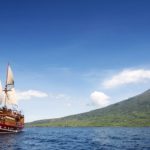
Link up with a dive group
Online groups are often looking to add divers to their roster for a trip. Search social media and Google, joining every group you can find that piques your interest. Whatever your dive passion, you’ll discover a group and a trip to suit you whether you prefer wreck diving, budget travel, or a remote excursion.
Join a solo traveler-site dedicated to divers
Pair up with a buddy on a network that caters to single divers (i.e., divers not in a relationship) or buddy-less divers (i.e., divers in a relationship without a dive buddy). You can connect with a travel companion to book a trip together, join a diver on a trip already booked, or post a trip looking for someone to join you. Two good sites include Single Divers and Singles Who Scuba.
 Look for last-minute rooms
Look for last-minute rooms
Some hotels and resorts offering last-minute rooms won’t ding you with a single supplement. Sometimes, they just want a full house, so look for trips and rooms available in the next 30 days Better yet, if you’re flexibile enough, look for the next two weeks. Sometimes, you can snag a steal even at a lavish resort.
Ask for a discount on rooms far in advance
Conversely, other hotels and resorts prefer to establish advance bookings and offer discounts for dates far in the future. While this occurs less often than cheap, last-minute rooms, we secured a bungalow at a South Pacific resort a year and a half in advance, minus the 35 percent single supplement they usually include. We also paid the current year’s rates and not the following year’s price raised by inflation.
Negotiate
A number of hotels and resorts will negotiate if you contact them directly instead of relying on a travel site. Always ask for a discount even if none are listed, particularly during the off season or the shoulder season. They may waive the single supplement, offer a discount, or furnish extras such as free nitrox or equipment rental. The worst they can say is no.
 Enjoy a home stay
Enjoy a home stay
Consider a home share or home exchange. At home-sharing sites, such as Airbnb and HomeAway, you’ll pay a nightly, weekly, or monthly fee to rent a room in someone’s home or rent the entire house. Some properties equate to the price of a hotel, but some are incredibly cheap.
At home exchange sites such as Intervac and HomeLink, you’ll pay a small annual fee, around $100, to the home-exchange company and then you’ll swap homes with someone for the length of your vacation. Instead of paying money, you exchange free accommodation.
Bonus Tip: find a place so cheap the fee doesn’t matter
Don’t forget that some places remain cheap enough that a tacked-on single supplement won’t hurt too much. We’ve found this more consistently true in spots like Mexico and Indonesia, so a search in these locations could offer up a bargain trip.
The post Top Tips for Traveling Alone appeared first on Scuba Diver Life.
from Scuba Diver Life https://ift.tt/2J4t04Z
Top Tips for Traveling Alone
Whether you love solo travel or just lack a dive buddy, no one likes the extra fees often facing travelers who claim a room for themselves. Termed a 'single supplement,' this additional fee tacks on anywhere from 10 to a whopping 100 percent of the standard room rate to your bill if you don't meet the double-occupancy guidelines. Here are our eight top tips for traveling alone and avoiding the dreaded single supplement on your next dive trip.
Travel with a dive shop
Sign up for a group trip and avoid the 'single' part altogether. Dive shops often offer group trips to tropical locales like the Bahamas or even far-flung destinations like the Maldives. They'll also pair you up with a good dive buddy. Though your local dive shop remains an easy first choice, you're not limited to businesses in your area. Many dive shops also offer out-of-state divers a chance to join their trips.
Share a room
Land-based properties usually require a single supplement unless you're in a shared room. Often designed for backpackers, these rooms generally house at least two travelers and sometimes many more. You'll share bathroom facilities but enjoy access to a kitchen, which can also cut down on your meal costs. We adore the Agnes Gateway Hotel on the remote island of Munda in the Solomon Islands, which offers a variety of rooms including these types of budget rooms. The property also houses the award-winning Dive Munda.
While some resorts offer shared rooms, you'll have more luck on the water as this is usually a standard liveaboard option. Since you'll be bunking with one to three other divers, a guaranteed dive buddy is a part of the package. While the cost may seem high at first glance, remember that the fee includes the room, all meals, and the diving. These liveaboard rooms can range from bare bones to luxurious. One of our favorites is the Arenui Boutique Liveaboard, which not only offers elegant shared rooms, but some of the best diving in Indonesia.

Link up with a dive group
Online groups are often looking to add divers to their roster for a trip. Search social media and Google, joining every group you can find that piques your interest. Whatever your dive passion, you'll discover a group and a trip to suit you whether you prefer wreck diving, budget travel, or a remote excursion.
Join a solo traveler-site dedicated to divers
Pair up with a buddy on a network that caters to single divers (i.e., divers not in a relationship) or buddy-less divers (i.e., divers in a relationship without a dive buddy). You can connect with a travel companion to book a trip together, join a diver on a trip already booked, or post a trip looking for someone to join you. Two good sites include Single Divers and Singles Who Scuba.
 Look for last-minute rooms
Look for last-minute rooms
Some hotels and resorts offering last-minute rooms won't ding you with a single supplement. Sometimes, they just want a full house, so look for trips and rooms available in the next 30 days Better yet, if you're flexibile enough, look for the next two weeks. Sometimes, you can snag a steal even at a lavish resort.
Ask for a discount on rooms far in advance
Conversely, other hotels and resorts prefer to establish advance bookings and offer discounts for dates far in the future. While this occurs less often than cheap, last-minute rooms, we secured a bungalow at a South Pacific resort a year and a half in advance, minus the 35 percent single supplement they usually include. We also paid the current year's rates and not the following year's price raised by inflation.
Negotiate
A number of hotels and resorts will negotiate if you contact them directly instead of relying on a travel site. Always ask for a discount even if none are listed, particularly during the off season or the shoulder season. They may waive the single supplement, offer a discount, or furnish extras such as free nitrox or equipment rental. The worst they can say is no.
 Enjoy a home stay
Enjoy a home stay
Consider a home share or home exchange. At home-sharing sites, such as Airbnb and HomeAway, you'll pay a nightly, weekly, or monthly fee to rent a room in someone's home or rent the entire house. Some properties equate to the price of a hotel, but some are incredibly cheap.
At home exchange sites such as Intervac and HomeLink, you'll pay a small annual fee, around $100, to the home-exchange company and then you'll swap homes with someone for the length of your vacation. Instead of paying money, you exchange free accommodation.
Bonus Tip: find a place so cheap the fee doesn't matter
Don't forget that some places remain cheap enough that a tacked-on single supplement won't hurt too much. We've found this more consistently true in spots like Mexico and Indonesia, so a search in these locations could offer up a bargain trip.
The post Top Tips for Traveling Alone appeared first on Scuba Diver Life.
from Scuba Diver Life https://ift.tt/2J4t04Z
Wednesday, May 30, 2018
The rise of reservation re-sale (and why Airbnb is involved)
Flexible cancellation is a cornerstone of the OTA offering, even if hotels bear the brunt - and the cost - of accommodating it.
from HOTELMARKETING.COM https://ift.tt/2J1goLP
The pros and cons of listing hotels on Airbnb
The experience of one property that lists on the platform indicates that hoteliers should prepare for a different kind of booking experience with Airbnb.
from HOTELMARKETING.COM https://ift.tt/2LMEjRa
Here’s Mary Meeker’s essential 2018 Internet Trends report
Want to understand all the most important tech stats and trends? Legendary venture capitalist Mary Meeker has just released the 2018 version of her famous Internet Trends report.
from HOTELMARKETING.COM https://ift.tt/2J2EzJQ
How travel brands should tackle attribution
Travel brands should attack the issue of attribution from multiple angles, finds a brand new report from EyeforTravel.
from HOTELMARKETING.COM https://ift.tt/2LLVum0
Sabre joins forces with Microsoft to reimagine the business of travel
Together the two companies will work to help Sabre better harness the power of its data and apply artificial intelligence and advanced analytics to create new services for hotel, agency and airline customers.
from HOTELMARKETING.COM https://ift.tt/2xtrkRh
Report: Airbnb benefits local economies more than chain hotels
Airbnb travelers engage with destinations through a more diverse set of activities than travelers who stay in traditional accommodations, the company claims.
from HOTELMARKETING.COM https://ift.tt/2Jl3agv
Airbnb goes it alone in the battle over China
Some investors oppose the strategy and would prefer the company to tie up with local home-sharing leader Tujia.
from HOTELMARKETING.COM https://ift.tt/2LbGEnM
US: Promising signs for group demand
Several CEOs from US hotel companies report group demand, specifically corporate group demand, appears to be on its way back.
from HOTELMARKETING.COM https://ift.tt/2JkfqxI
Cedar Creek in the heart of South Burnaby
Ledingham McAllister is excited to announce the launch of Cedar Creek, coming soon to the heart of South Burnaby. Inspired by the majestic Cedar, these six-storey, wood-frame residences embody West Coast design and convenient living in the established Edmonds neighbourhood. A fresh new community within walking distance of shopping, education, entertainment, recreation, SkyTrain, and every conceivable amenity for easy and active living.This beautiful collection of 1 bedroom and den to 3 bedroom homes, ranging in size from 635 to 995 sq.ft., all boast overheight ceilings, open floor plans, premium appliances and extensive glazing for the brightest and most livable of homes.
The post Cedar Creek in the heart of South Burnaby appeared first on Vancouver New Condos.
from Buildings – Vancouver New Condos https://ift.tt/2xsPivZ
Besides blogging, here are 5 ways to quit your job and travel
Five years ago I walked into my boss's office with sweaty palms and a cracking my voice and handed in my resignation. I wasn't going to a competitor. I wasn't moving companies. I was DONE. I was done with working in an office. I was done with feeling unfulfilled in my work. I was done meticulously counting my vacation days like a kid counts pennies.
It took a long time but I had finally mustered up the courage to recognize my true passions and things I really wanted to devote my energy and time to. I wanted to live abroad and become a writer and photographer. I wanted the freedom of working for myself while being able to inspire others. I was full of passion and excitement.
And nerves. LOTS of nerves.

I had the big picture all laid out but there were a lot of unknowns and a lot of trial and error. Five years ago, I didn't have the luxury of endless online support and blueprints. I was fumbling my way through the dark trying to make sense of it all, learning from my mistakes and trusting my gut and following my intuition.
After a lot of hard work and too many sleepless nights, I finally began realizing it was working. I was living. And traveling. And completely self-sustaining. The life I dreamed of was becoming a reality and I knew I had made the right call.
Like so often in life, all it takes is a leap of faith. And a whole lot of trust in yourself.

You hear so often these days about bloggers quitting their jobs to travel (hello!) but I'm not saying you need to quit your job to pursue blogging. In fact, today I'm going to argue you don't do that.
Just because it's what worked for me, doesn't mean that my path should be the same for everyone. Writing and photography isn't everyone's cup of tea, and behind the glam and pretty photos, it's a lot harder and much more time consuming than anyone could imagine. Success as a blogger is never guaranteed, and it takes a lot of hard work, stubbornness and creative thinking to make it work.
But listen, just because you're not interested in a blogging career doesn't mean your chance at a fulfilling career that lets you travel is out of reach.

Blogging is one of the hundreds of ways to be self-employed and travel the world while working remotely. I don't know about you guys, but my life goal has always been to work less and travel more.
And you're in luck because it's 2018 and there's literally information EVERYWHERE about exactly how to do this and be successful. One of my biggest secrets is that I'm all about upskilling, and trying to teach myself new tricks, hacks, and lessons that I can apply to making my business infinitely better. There is always something new to learn beyond what I have figured out on my own.
Every year I patiently way for when the Paradise Pack goes on sale, and I've been a loyal buyer every year since 2015. A massive collection of all the best online courses taught by experts that goes on sale once a year for a week, it's worth over $8000 and this year is $497. It's everything you need to create an online lifestyle business from scratch that earns you a serious income.
I get it, $500 ain't cheap, but in the long run, it's worth the investment, and it'll pay itself off with probably one sale, job or commission. Doesn't that make it worth it already?
The Paradise Pack is literally handing you roadmaps to success in every avenue you could imagine. Not into blogging? Don't sweat it. Here are five other ways to quit your job and travel without ever setting up a blog.

1. Make it as a freelancer
When people think of working in travel, the most common answer that first comes to mind is usually working as a freelance writer or photographer. Let's call it the more traditional path. It's certainly a part of what I do as well, but not all. But how do you start?
I get it. Freelancing can be an intimidating world. With ever-increasing competition, it can be hard to make yourself stand out from the crowd in a busy digital market. And if you do stand out, what next? How do you determine your prices? How do you track invoices? How do you make your business run as efficiently as possible?
Freelancer Start-Up Programme is part of the Paradise Pack offering in 2018, and it will jump start you in your freelancer career while still accommodating freelancers who are new and not quite ready to commit full time. There is another course in the pack that delves into working as a virtual assistant, which was one of my very first location-independent jobs.
If you're determined to make it as a travel writer and find yourself near Australia this June, on June 30th, my business partners and I are presenting our 5th Travel Bootcamp workshop on the Gold Coast, and Georgia Rickard is leading the sessions on writing and freelancing.

2. Build your own online business that doesn't suck
If you were to ask me where to focus on in 2018, this would be it. There are so many amazing ways to make it online. Why be tied to an office with limited vacations when you could be living like a king on the beach in Thailand?
But it's not easy. So many people have business ideas that never come to fruition. Only those who have both the end vision and the blueprint to get there see success and believe me, I know it's hard to see the path when you're the one creating it. But at the same time I know people who make
The Wantrepreneur to Entrepreneur Bootcamp is designed to help you make that giant leap, giving you step-by-step instructions and ready-made templates to get your idea off the ground. There is even an exclusive course in the Paradise Pack worth over $1200 included that teaches you exactly how to build an online business with a 4 hour work week. Hello, who doesn't want that? This one is what pushed me over the edge this year into buying it.

3. Travel hacking with frequent flyer points
One of the biggest barriers to travel is the cost of flying. Sure, Europe has those cheap airlines that practically charge you if you sneeze on their aircraft but that's not the only way to travel on the cheap.
The Frequent Flyer Bootcamp 2.0 is a world best-selling course on travel hacking frequent flier miles and is included in the Paradise Pack this year. Imagine flying worldwide for under $100?! Travel just became a whole lot more accessible.
Now travel hacking isn't necessarily a career job, but if it saves you thousands and thousands and allows for free or basically free travel, wow, then that is worth it, isn't it?

4. Podcast your way to success
Podcasting has seen a huge increase in popularity over the past few years and for good reason. People are always looking for inspiration and entertainment through their earbuds while the face the daily commute or while they're out for their morning run.
With Irresistible Podcasting, you'll have step-by-step instruction laid out in a series of 11 module videos to show you how to create, grow and monetize your podcast, even without a huge audience!
I have become obsessed with Podcasts this past year, usually true crime and self-help ones, an odd mixture I'll admit, and I am hoping one day I can even start my own! That is, when I come up with a creative idea for one, and also get over the sound of my own voice.
Seriously, who is that breathy child on the phone? Oh, it's me. SHAME.

5. Become an influencer like me!
Now hear me out. I know that the word "influencer" might be the douchiest word out in existence but it also happens to be an epic career path, if you're willing to make it work. Perhaps it'll even be Oxford word of the year in 2018 (disclosure – I just made that up).
But I digress. Perhaps one of the newest ways to make money while traveling is become an influencer. I know, I know, you're shaking your head and cursing millennials right now, but bear with me.
People build entire careers out of creating and cultivating a brand. It's very likely you have at least one hobby or interest that really gets your blood racing. Something you can talk about for hours. If you can pinpoint what exactly you love doing, you can learn to build a brand around what you love, motive it and reap the benefits of building your name within that industry. The Hobby Hacking course will help you get from a passion to a career and there are other helpful courses in the Paradise Pack this year that are focused on branding, one of the hardest parts of online work.

So there you go. You don't need to be a verbose blogger to make a career out of travel.
You can have your cake and eat it too with the tools in the Paradise Pack but, as with any new venture, be prepared to work for it, not give up and don't take no for an answer.
My blogging career hasn't been luck. I have poured every ounce of passion and energy into this world for years, and often with no hope or thought of money, and you should be prepared for that too. It takes effort to study and learn and grow but I promise the handwork will be worth it. You just have to figure out the right path for you to take and with these tools, you'll be in an amazing position to figure out how.
I believe in you! You can do it!
Do you dream of traveling the world and working remotely? Any tips to share? Spill!

This post contains affiliate links
The post Besides blogging, here are 5 ways to quit your job and travel appeared first on Young Adventuress.
from Young Adventuress https://ift.tt/2sio1HM
Scuba diving in Koh Ha, Thailand
Koh Ha is a tiny group of uninhabited islands about an hour's boat ride from Trang on Thailand's southwest coast. Much like Thailand's Similan and Surin Islands, it's closed to the public for several months each year for the monsoon season, giving the marine environment time to regenerate before the next busy tourist season. However, this group of islands is closed for a few weeks more than the others for another reason — this is where the Thai Royal family likes to dive. What makes the scuba diving in Koh Ha so special?
Diving in Koh Ha
Above water, like a lot of the islands dotting the coast south of Krabi, the islands themselves are stunning, with tall limestone karsts rising dramatically out of the water. On the largest island, a white, sandy bay curves around a shallow turquoise lagoon.
Underwater the landscape is equally stunning featuring large boulders and rocky reefs, all thickly covered with colorful soft corals. There are several caverns and swim-throughs as well.
All manner of reef fish, damsels, wrasse, butterflyfish and coral trout flit about the soft coral. Anemonefish of all different types hover over the many anemones, while schools of snapper, fusiliers, jacks and barracuda swarm in the blue. In the crevices and caverns, giant moray eels, pufferfish and the odd giant grouper hide.
In the Thai language, "ha" means "five," so, as you'd expect, this tiny archipelago features five islands. Most dive sites are simply named after each one — No. 2, No. 3, etc. — with a few exceptions named for specific features, such as The Chimney and Twin Cathedrals.
Twin Cathedrals
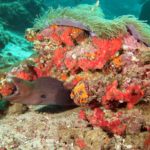
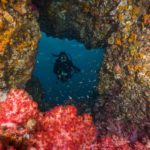
Our first dive is at Twin Cathedrals, named for its two enormous caverns. We descend next to the largest island and swim along the wall toward a few enormous boulders, worth exploring before we enter the first cavern.
Past the boulders there is a sloping reef, covered in a forest of whip corals descending about 82 feet (25 m), looking like something Dr. Seuss would have dreamed up. We swim back around this reef and through the enormous arched entrance to the first cavern where we ascend to a small air bubble to check it out. The cave extends another 160 feet (50 m) above water. It's an impressive sight, worth checking out before swimming through another grand arch to the second slightly smaller cavern.
No. 2 and No. 4
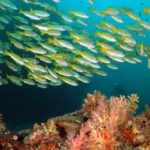
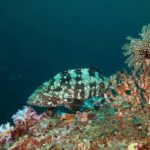
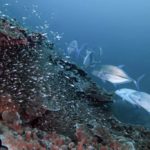
Our next dive is a combination of No. 2 and No. 4, featuring more rocky reefs and large boulders covered in brightly colored hard and soft corals, as well as large sea fans. Schools of fusiliers and snapper fly over them, and all sorts of damsels, butterflies and anthias dart in and around the coral formations. Down at about 80 feet (25 m), a huge school of jacks appears from the blue and circles us as we try to capture them on film.
The Chimney
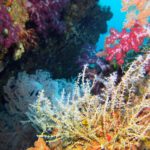
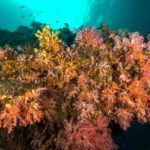

Our third dive is named after one of its main features, the Chimney, where we descend to around 65 feet (20 m) before it opens into a small cavern lined with soft coral and full of curious big eyes. Outside the cavern is a large bowl, protected on all sides by large boulders. Smaller boulders hold large garden of anemones, which we spend lots of time exploring before heading into the shallow coral gardens.
Each dive is as stunning as the next, and after only three dives it's easy to see why the royal family loves it so much.
Deborah Dickson-Smith is one half of Diveplanit, a dive travel website she manages with her partner Simon Mallender, based in Australia.
The post Scuba diving in Koh Ha, Thailand appeared first on Scuba Diver Life.
from Scuba Diver Life https://ift.tt/2IXRQ6y
Scuba diving in Koh Ha, Thailand
Koh Ha is a tiny group of uninhabited islands about an hour’s boat ride from Trang on Thailand’s southwest coast. Much like Thailand’s Similan and Surin Islands, it’s closed to the public for several months each year for the monsoon season, giving the marine environment time to regenerate before the next busy tourist season. However, this group of islands is closed for a few weeks more than the others for another reason — this is where the Thai Royal family likes to dive. What makes the scuba diving in Koh Ha so special?
Diving in Koh Ha
Above water, like a lot of the islands dotting the coast south of Krabi, the islands themselves are stunning, with tall limestone karsts rising dramatically out of the water. On the largest island, a white, sandy bay curves around a shallow turquoise lagoon.
Underwater the landscape is equally stunning featuring large boulders and rocky reefs, all thickly covered with colorful soft corals. There are several caverns and swim-throughs as well.
All manner of reef fish, damsels, wrasse, butterflyfish and coral trout flit about the soft coral. Anemonefish of all different types hover over the many anemones, while schools of snapper, fusiliers, jacks and barracuda swarm in the blue. In the crevices and caverns, giant moray eels, pufferfish and the odd giant grouper hide.
In the Thai language, “ha” means “five,” so, as you’d expect, this tiny archipelago features five islands. Most dive sites are simply named after each one — No. 2, No. 3, etc. — with a few exceptions named for specific features, such as The Chimney and Twin Cathedrals.
Twin Cathedrals


Our first dive is at Twin Cathedrals, named for its two enormous caverns. We descend next to the largest island and swim along the wall toward a few enormous boulders, worth exploring before we enter the first cavern.
Past the boulders there is a sloping reef, covered in a forest of whip corals descending about 82 feet (25 m), looking like something Dr. Seuss would have dreamed up. We swim back around this reef and through the enormous arched entrance to the first cavern where we ascend to a small air bubble to check it out. The cave extends another 160 feet (50 m) above water. It’s an impressive sight, worth checking out before swimming through another grand arch to the second slightly smaller cavern.
No. 2 and No. 4



Our next dive is a combination of No. 2 and No. 4, featuring more rocky reefs and large boulders covered in brightly colored hard and soft corals, as well as large sea fans. Schools of fusiliers and snapper fly over them, and all sorts of damsels, butterflies and anthias dart in and around the coral formations. Down at about 80 feet (25 m), a huge school of jacks appears from the blue and circles us as we try to capture them on film.
The Chimney



Our third dive is named after one of its main features, the Chimney, where we descend to around 65 feet (20 m) before it opens into a small cavern lined with soft coral and full of curious big eyes. Outside the cavern is a large bowl, protected on all sides by large boulders. Smaller boulders hold large garden of anemones, which we spend lots of time exploring before heading into the shallow coral gardens.
Each dive is as stunning as the next, and after only three dives it’s easy to see why the royal family loves it so much.
Deborah Dickson-Smith is one half of Diveplanit, a dive travel website she manages with her partner Simon Mallender, based in Australia.
The post Scuba diving in Koh Ha, Thailand appeared first on Scuba Diver Life.
from Scuba Diver Life https://ift.tt/2IXRQ6y
3 Tips on Choosing the Perfect Carpet Color
Selecting a suitable carpet color for your home may sound easy. But there's actually a lot more to consider than what you may first realize. So before you head to the carpet store, make sure you've read the following tips first.
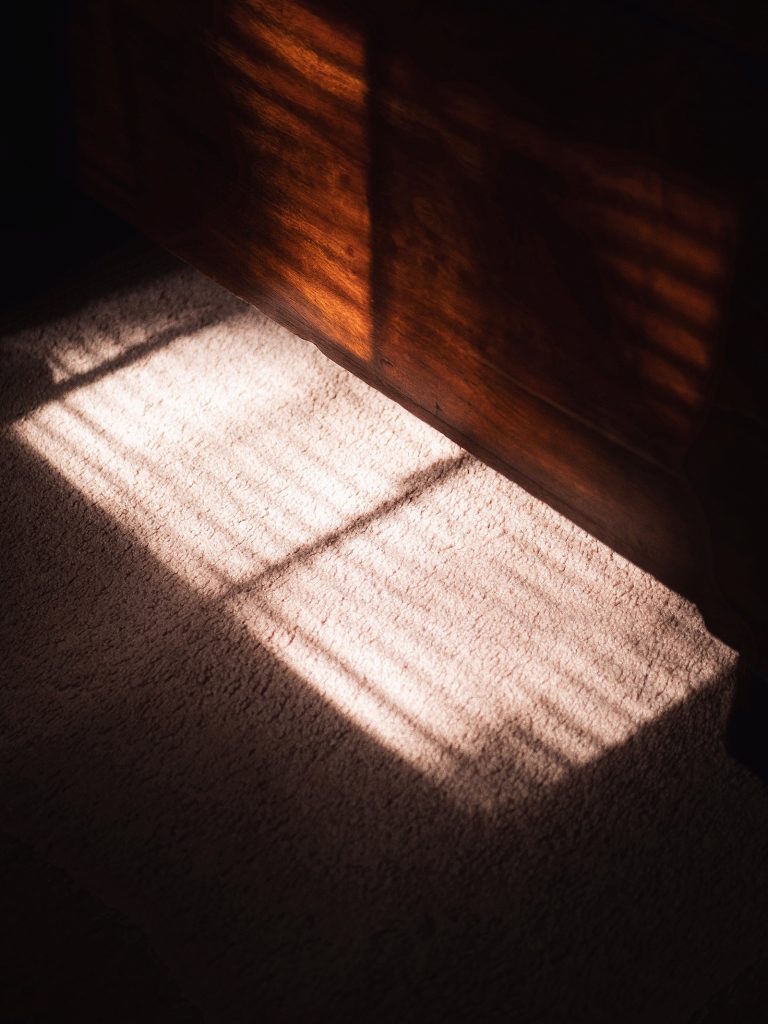 Photo by Brian Patrick Tagalog on Unsplash
Photo by Brian Patrick Tagalog on Unsplash
What's your lifestyle?
Your lifestyle and the way in which the carpeted room will be used are huge considerations in carpet color. A busy household with kids, pets and working parents doesn't usually lend itself well to white carpets, which can show soiling more easily than other colors.
Keep in mind that very light and very dark colors show far more undesirable debris than mid-tones.
While a dark color may be great at hiding stains, it will show lint and dust more than other colors. A carpet that is neither too light nor too dark will be the best color for masking these issues. Source: TheSpruce
Get inspiration from within the room
The endless number of carpet and paint combinations can have you spinning in circles, but there are a couple of decorator tricks to help make the palette-picking process a little less dizzying. Turn to your artwork; if you have a beloved painting or print for the space, pull a more dominant color from it for the carpet and pick one of the picture's background tones for the walls. This can bring the room together and let the artwork shine. If you plan to keep your sofa for a long time, use its color for finishing ideas. Look across the color wheel from your couch's shade and use the opposing hue, such as orange across from blue or mauve across from yellow, for pleasant contrast. Then ground the space by choosing carpeting that's similar to the walls or to the sofa but slightly darker. Source: HomeGuides.SFGate
Consider use of space
Do you want your carpet to brighten up a dark room or tone down a too-light space? Red is a perfect choice for darker family rooms, living rooms and hallways. It wears well and tends not to show stains as badly as some of the lighter colors. For rooms that have excessive sunlight, you will need to also think about fading, a problem that is more obvious with dark carpets. Source: ColorCombos
We can help you determine the perfect carpet for your home and we can also install it for you. Call us today!
The post 3 Tips on Choosing the Perfect Carpet Color appeared first on Curlys Carpet Repair.
from Curlys Carpet Repair https://ift.tt/2shjDsk
3 Tips on Choosing the Perfect Carpet Color
Selecting a suitable carpet color for your home may sound easy. But there’s actually a lot more to consider than what you may first realize. So before you head to the carpet store, make sure you’ve read the following tips first.
 Photo by Brian Patrick Tagalog on Unsplash
Photo by Brian Patrick Tagalog on Unsplash
What’s your lifestyle?
Your lifestyle and the way in which the carpeted room will be used are huge considerations in carpet color. A busy household with kids, pets and working parents doesn’t usually lend itself well to white carpets, which can show soiling more easily than other colors.
Keep in mind that very light and very dark colors show far more undesirable debris than mid-tones.
While a dark color may be great at hiding stains, it will show lint and dust more than other colors. A carpet that is neither too light nor too dark will be the best color for masking these issues. Source: TheSpruce
Get inspiration from within the room
The endless number of carpet and paint combinations can have you spinning in circles, but there are a couple of decorator tricks to help make the palette-picking process a little less dizzying. Turn to your artwork; if you have a beloved painting or print for the space, pull a more dominant color from it for the carpet and pick one of the picture’s background tones for the walls. This can bring the room together and let the artwork shine. If you plan to keep your sofa for a long time, use its color for finishing ideas. Look across the color wheel from your couch’s shade and use the opposing hue, such as orange across from blue or mauve across from yellow, for pleasant contrast. Then ground the space by choosing carpeting that’s similar to the walls or to the sofa but slightly darker. Source: HomeGuides.SFGate
Consider use of space
Do you want your carpet to brighten up a dark room or tone down a too-light space? Red is a perfect choice for darker family rooms, living rooms and hallways. It wears well and tends not to show stains as badly as some of the lighter colors. For rooms that have excessive sunlight, you will need to also think about fading, a problem that is more obvious with dark carpets. Source: ColorCombos
We can help you determine the perfect carpet for your home and we can also install it for you. Call us today!
The post 3 Tips on Choosing the Perfect Carpet Color appeared first on Curlys Carpet Repair.
from Curlys Carpet Repair https://ift.tt/2shjDsk
Tuesday, May 29, 2018
eDreams Odigeo to offer ‘cancel for any reason’ cover
Customers of eDreams Odigeo will be to cancel flights up to 24 hours before departure and still receive a refund of 80% of the ticket cost.
from HOTELMARKETING.COM https://ift.tt/2Jh4Lnv
Business travelers ‘apprehensive’ about Brexit
New research reveals business travelers are feeling more uneasy about Brexit than they did before the referendum.
from HOTELMARKETING.COM https://ift.tt/2L2Cn5V
The bizarre case of Renaissance Hotels’ Facebook decline
Renaissance Hotels, the up-market brand now owned by Marriott, is on an inexplicable and precipitous slide… when it comes to Facebook likes.
from HOTELMARKETING.COM https://ift.tt/2JfWIap
Search is more than Google: Mastering vertical search optimization
Vertical search engines, mobile and voice trends seem to be reshaping the search landscape, creating a cohesive content strategy across a number of verticals, increasing the touch points you have with consumers.
from HOTELMARKETING.COM https://ift.tt/2L70nVA
Which direct booking incentives actually work?
Looking across our diverse portfolio, Tambourine evaluated which book-direct benefits have a low cost, but a high perceived value to guests.
from HOTELMARKETING.COM https://ift.tt/2JfzeCs
Tell your hotel brand story on social media
With some creativity and planning, every hotel can define their own brand identity and communicate this with their target audience. Here's how to get started.
from HOTELMARKETING.COM https://ift.tt/2L8PouS
A comprehensive approach to hotel channel distribution
Big brands, OTAs, GDS's, and metasearch websites are all vying for customer attention, and it's all affecting hotel margins.
from HOTELMARKETING.COM https://ift.tt/2svhcBZ
US lodging metrics continue to remain positive
First quarter results yielded stronger than expected increases in demand for many hotel companies, as well as slightly stronger rate growth, driven primarily by an increase in commercial transient travelers, according to new PwC data.
from HOTELMARKETING.COM https://ift.tt/2kxgsIC
Renovations that Increase Your Home’s Value
Content originally published and Shared from http://perfectbath.com
The best way to increase the price of your home before selling is to make some renovations. Below, you'll see the most profitable upgrades that you should do before putting your home on sale.
 Photo by Milivoj Kuhar on Unsplash
Photo by Milivoj Kuhar on Unsplash
Adding another bathroom or updating current one
If your home only has one bathroom, you can recoup a large chunk of your investment by adding another one. HGTV estimates that you can recoup 80%-130% of whatever you spend adding a bathroom.
When it comes to finding room in your house for an extra bathroom, take a look at any extra rooms or underutilized spaces. Consider other spaces, such as closets or areas under the stairs, too. If you want a half-bath you need at least 18 square feet. If you want a full bath, including a stand-up shower, you need at least 30 square feet. If you want a bathtub, make sure you have at least 35 square feet to work with for a bathroom addition. See these bathroom design and remodeling ideas to get you started. Source: MoneyCrashers
Outdoor area
"There is a definite trend towards upgrading outdoor areas to more indoor outdoor living," says Harris. "An alfresco area in the past was a barbie on the patio where as now the outdoor area is an extra room, an all-weather extension of the house. The money spent on a well-designed all weather area brings its returns when the sale sign goes up. The outdoor area is an emotional driver for buyers. They see the area, imagine themselves using it and already they are sold on the lifestyle it offers." Source: Domain
Modern kitchen
A full remodel is a major investment, but smaller projects make a big difference if you can't — or don't want to — go all out. "Nicer appliances really stick out to potential buyers — even if you're planning to take them with you," Fancher says.
She also suggests replacing tired finishes with fresh, neutral materials. "You don't want to be too trendy, but you want it to look up-to-date," she says. "Everyone loves clean, white subway tiles now, but they're really a timeless look."
Replacing dated countertops (quartz is your best bet, according to Fancher) and flooring is also worth the time and money. Source: Zillow
Looking for the best quality bathroom fixtures for your new or upgraded bathroom? Check us out today!
Contact:
Perfect Bath
Phone: Toll Free 1-866-843-1641
Calgary, Alberta
Email: info@perfectbath.com
The post Renovations that Increase Your Home's Value appeared first on Perfect Bath Canada.
from Perfect Bath Canada https://ift.tt/2siLl7X
Best Scuba Diving in Southern Mozambique: Part II
Scuba diving in southern Mozambique is so fantastic that we've split our favorite options into two articles. See our first story here, which features more details on how to get to (and around) Mozambique, what to expect once you arrive, and when to go for the best diving. Here are our picks for our second set of southern Mozambique's best dive sites.
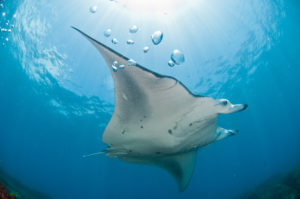
Tofo and Barra
Where is it: Tofo and Barra are located about six miles (10 km) apart in the bay of Inhambane, located in Inhambane province, about 500 km (800 km) north of Maputo.
What makes it special: The area is probably one of Mozambique's most famous dive destinations as travelers flock to enjoy the calm, clear waters and to see the mantas and whale sharks that usually migrate through the area. The bay of Inhambane, where Tofo and Barra are located, has calm waters with hardly any waves, offering a contrast to dive locations further south that feature rolling waves and (sometimes) tricky boat launches. The area has three manta-cleaning stations with lots of gullies, overhangs and ledges covered in hard and soft coral. Advanced divers can participate in deep drift dives along the walls and drop-offs. You are likely to see whale sharks, shoals of game fish, ghost pipefish, leaf fish, green turtles and a variety of sharks.
The main attractions in Tofo are mantas and whale sharks. You can see mantas throughout the year, and you're most likely to spot whale sharks from October to April, although they are generally around most of the year. A trip to Barra lagoon, just off the beach in Barra, will delight you with its seahorse population. You might also see humpback whales between June and October.
Details: There are a number of flights from South Africa to Inhambane. You can travel from there via taxi to Tofo and Barra or arrange for an airport pick up. Travel time in a car from Maputo could take you about 8 to 10 hours with the last part of the way being on dirt road. There are a variety of accommodation options and dive operators to meet your needs.
When to go: Diving is good all year with water temperatures varying from 75 F (24 C) in the winter (June to August) to 84 F (29 C) in the summer (November to February). Reef depths vary from 59 to 130 feet (18 to 40 m. Visibility varies from 33 to 100 feet (10 to 30 m) and can change drastically from day to day.
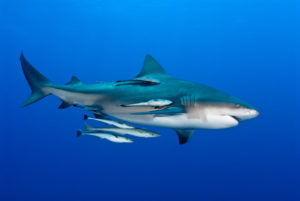
Pomene and Morrungulo
Where is it: Pomene is located between Vilanculos and the town of Maxixe about 370 miles (600 km) north of Maputo. Morrungulu is about an hour and a half south of Pomene.
What makes it special: Manta encounters are likely on nearly every reef. There are many cleaning stations, caves and swim-throughs. You could also see sailfish, marlin and wahoo, as well as mobula and eagle rays. There are both a horse head, and a hand-shaped rock formation underwater and a cave with frequent bull-shark sightings. Interesting topography, such as fossilized stone gullies and occasional hammerhead sightings make dives on this continental shelf extra special.
Details: Pomene is about three hours from the nearest main road. You can drive to Pomene from Maputo or fly to Inhambane and then drive or take a taxi to your hotel. Driving from Maputo could take between 9 and 13 hours while driving from Inhambane will take from 4 to 6 hours. The dirt road between the main road and Pomene requires a four-wheel-drive vehicle and can be difficult to navigate. There are a few dive centers and accommodation options in Pomene and Morrungulo.
When to go: Diving is good all year with water temperatures varying from 75 F (24 C) in the winter to 84 F (29 C) in the summer. Reef depths vary from 30 to 105 feet (10 to 32 m), offering something for divers from all levels. Visibility varies from 30 to 100 feet (10 to 30 m).
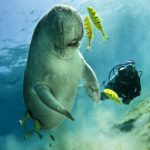
Vilanculos Archipelago
Where is it: Vilanculos is a small coastal town about 435 miles (700 km) north of Maputo.
What makes it special: Here you could see dugongs as well as rays, turtles and game fish. There are humpback whales from June to October, whale sharks most of the year, and sharks ranging from silvertips to hammerheads. There are even Zambezi sharks in the area. Unique underwater topography means you'll find sites where the coral looks like fairy castles and fossilized trees protruding from the ocean floor. Dive sites run the gamut from calm, shallow and relaxed for beginners to sites with strong currents where more-experienced divers can enjoy drift diving.
Details: You can either drive up or fly from Maputo to Vilanculos airport. The drive from Maputo to Vilanculos takes between 9 and 14 hours, while flights are about an hour and a half.
When to go: Diving is good all year with water temperatures varying from 75 F (24 C) in the winter to 84 F (29 C) in the summer. Reef depths vary from 20 to 144 feet (6 to 44 m), offering diving for divers from all levels. Visibility varies from 30 to 100 feet (10 to 30 m).
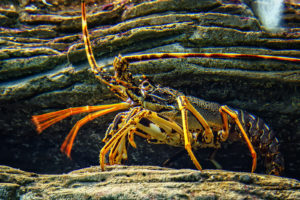
Bazaruto National Park
Where is it: Bazaruto National Park is a string of six islands nine miles (15 km) off the coast of Mozambique between Africa and Madagascar.
What makes it special: The sparsely populated Bazaruto Archipelago features one of the largest marine-conservation areas in the Indian Ocean, spanning 540 square miles (1400km²). The national park was created in 1971 to protect dugong and marine turtles and their habitats. You might also see a variety of dolphins and sharks, lots of healthy hard and soft coral and possibly humpback whales. There's also an abundance of giant lobsters, green turtles, rays and game fish.
Details: You can take a boat from Vilanculos to the Bazaruto islands, and it's best to discuss this option with your hotel. There are a few hotels and dive operators in the Bazaruto Archipelago and many dive operators from Vilanculos can assist with diving in Bazaruto.
When to go: Diving is good all year with water temperatures varying from 75 F (24 C) in the winter to 84 F (29 C) in the summer. Reef depths vary from 60 to 130 feet (18 to 40 m), offering something for divers from all levels. Visibility varies from 30 to 100 feet (10 to 30 m).
The post Best Scuba Diving in Southern Mozambique: Part II appeared first on Scuba Diver Life.
from Scuba Diver Life https://ift.tt/2smFWfn
Best Scuba Diving in Southern Mozambique: Part II
Scuba diving in southern Mozambique is so fantastic that we’ve split our favorite options into two articles. See our first story here, which features more details on how to get to (and around) Mozambique, what to expect once you arrive, and when to go for the best diving. Here are our picks for our second set of southern Mozambique’s best dive sites.

Tofo and Barra
Where is it: Tofo and Barra are located about six miles (10 km) apart in the bay of Inhambane, located in Inhambane province, about 500 km (800 km) north of Maputo.
What makes it special: The area is probably one of Mozambique’s most famous dive destinations as travelers flock to enjoy the calm, clear waters and to see the mantas and whale sharks that usually migrate through the area. The bay of Inhambane, where Tofo and Barra are located, has calm waters with hardly any waves, offering a contrast to dive locations further south that feature rolling waves and (sometimes) tricky boat launches. The area has three manta-cleaning stations with lots of gullies, overhangs and ledges covered in hard and soft coral. Advanced divers can participate in deep drift dives along the walls and drop-offs. You are likely to see whale sharks, shoals of game fish, ghost pipefish, leaf fish, green turtles and a variety of sharks.
The main attractions in Tofo are mantas and whale sharks. You can see mantas throughout the year, and you’re most likely to spot whale sharks from October to April, although they are generally around most of the year. A trip to Barra lagoon, just off the beach in Barra, will delight you with its seahorse population. You might also see humpback whales between June and October.
Details: There are a number of flights from South Africa to Inhambane. You can travel from there via taxi to Tofo and Barra or arrange for an airport pick up. Travel time in a car from Maputo could take you about 8 to 10 hours with the last part of the way being on dirt road. There are a variety of accommodation options and dive operators to meet your needs.
When to go: Diving is good all year with water temperatures varying from 75 F (24 C) in the winter (June to August) to 84 F (29 C) in the summer (November to February). Reef depths vary from 59 to 130 feet (18 to 40 m. Visibility varies from 33 to 100 feet (10 to 30 m) and can change drastically from day to day.

Pomene and Morrungulo
Where is it: Pomene is located between Vilanculos and the town of Maxixe about 370 miles (600 km) north of Maputo. Morrungulu is about an hour and a half south of Pomene.
What makes it special: Manta encounters are likely on nearly every reef. There are many cleaning stations, caves and swim-throughs. You could also see sailfish, marlin and wahoo, as well as mobula and eagle rays. There are both a horse head, and a hand-shaped rock formation underwater and a cave with frequent bull-shark sightings. Interesting topography, such as fossilized stone gullies and occasional hammerhead sightings make dives on this continental shelf extra special.
Details: Pomene is about three hours from the nearest main road. You can drive to Pomene from Maputo or fly to Inhambane and then drive or take a taxi to your hotel. Driving from Maputo could take between 9 and 13 hours while driving from Inhambane will take from 4 to 6 hours. The dirt road between the main road and Pomene requires a four-wheel-drive vehicle and can be difficult to navigate. There are a few dive centers and accommodation options in Pomene and Morrungulo.
When to go: Diving is good all year with water temperatures varying from 75 F (24 C) in the winter to 84 F (29 C) in the summer. Reef depths vary from 30 to 105 feet (10 to 32 m), offering something for divers from all levels. Visibility varies from 30 to 100 feet (10 to 30 m).

Vilanculos Archipelago
Where is it: Vilanculos is a small coastal town about 435 miles (700 km) north of Maputo.
What makes it special: Here you could see dugongs as well as rays, turtles and game fish. There are humpback whales from June to October, whale sharks most of the year, and sharks ranging from silvertips to hammerheads. There are even Zambezi sharks in the area. Unique underwater topography means you’ll find sites where the coral looks like fairy castles and fossilized trees protruding from the ocean floor. Dive sites run the gamut from calm, shallow and relaxed for beginners to sites with strong currents where more-experienced divers can enjoy drift diving.
Details: You can either drive up or fly from Maputo to Vilanculos airport. The drive from Maputo to Vilanculos takes between 9 and 14 hours, while flights are about an hour and a half.
When to go: Diving is good all year with water temperatures varying from 75 F (24 C) in the winter to 84 F (29 C) in the summer. Reef depths vary from 20 to 144 feet (6 to 44 m), offering diving for divers from all levels. Visibility varies from 30 to 100 feet (10 to 30 m).

Bazaruto National Park
Where is it: Bazaruto National Park is a string of six islands nine miles (15 km) off the coast of Mozambique between Africa and Madagascar.
What makes it special: The sparsely populated Bazaruto Archipelago features one of the largest marine-conservation areas in the Indian Ocean, spanning 540 square miles (1400km²). The national park was created in 1971 to protect dugong and marine turtles and their habitats. You might also see a variety of dolphins and sharks, lots of healthy hard and soft coral and possibly humpback whales. There’s also an abundance of giant lobsters, green turtles, rays and game fish.
Details: You can take a boat from Vilanculos to the Bazaruto islands, and it’s best to discuss this option with your hotel. There are a few hotels and dive operators in the Bazaruto Archipelago and many dive operators from Vilanculos can assist with diving in Bazaruto.
When to go: Diving is good all year with water temperatures varying from 75 F (24 C) in the winter to 84 F (29 C) in the summer. Reef depths vary from 60 to 130 feet (18 to 40 m), offering something for divers from all levels. Visibility varies from 30 to 100 feet (10 to 30 m).
The post Best Scuba Diving in Southern Mozambique: Part II appeared first on Scuba Diver Life.
from Scuba Diver Life https://ift.tt/2smFWfn